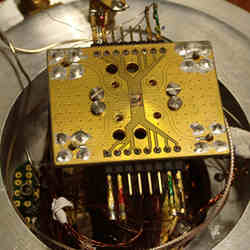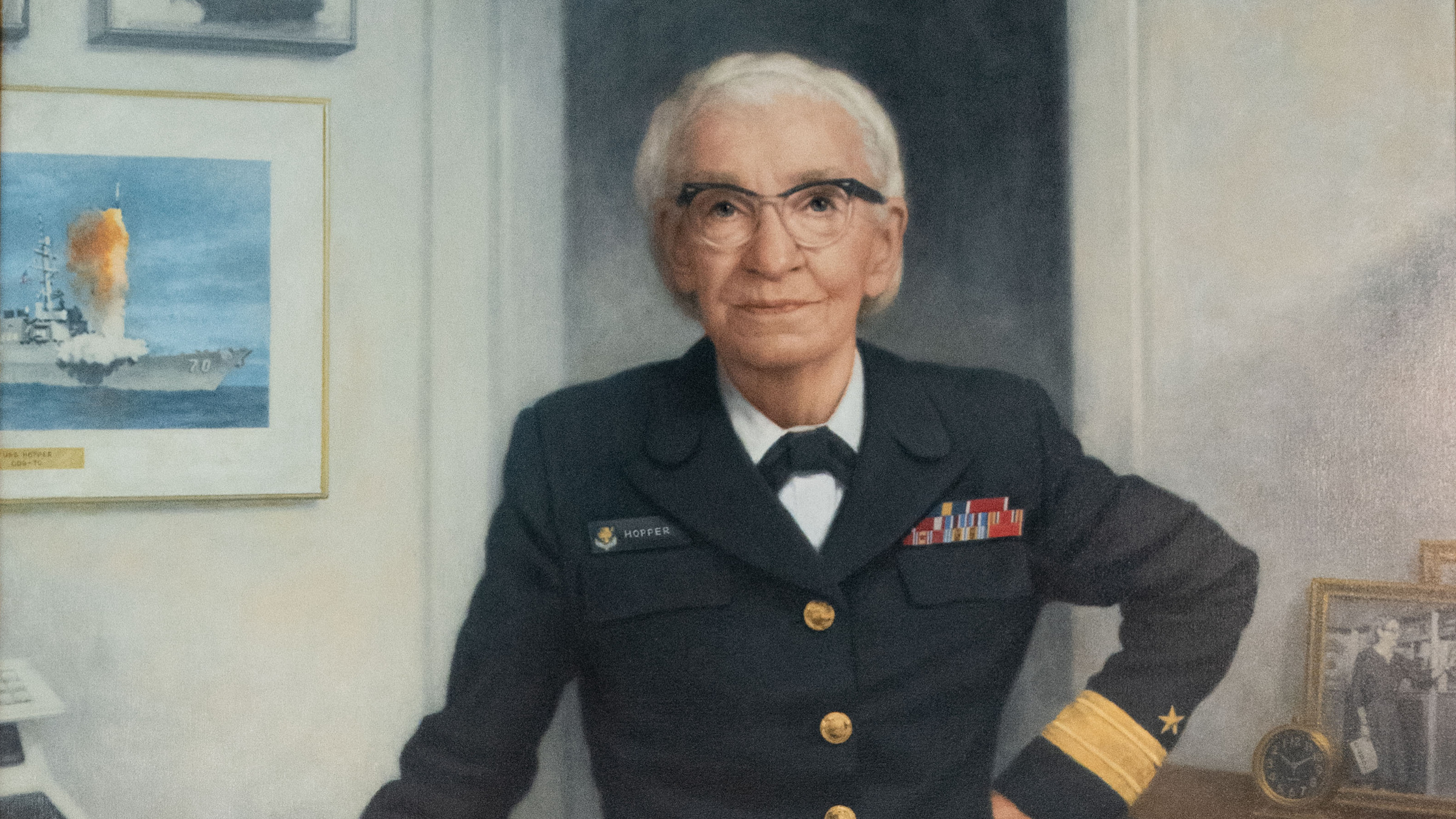
Quantum particles can get 'entangled,' in some sense keeping in touch no matter how far apart they are. This would enable absolutely secure communication, among other things. In the next several months, physicists in Delft, the Netherlands, hope to demonstrate this over a kilometers-long optical fiber in their lab. The next stage will be creating entanglement over fibers between different cities. Possibly by 2020, the world's first quantum Internet will connect the Dutch cities Delft, Den Haag, Leiden and Amsterdam.
In 2015 and 2016, quantum physicists from QuTech, a joint initiative of the Netherlands Organisation for Applied Scientific Research (TNO) and the Delft University of Technology (TU Delft), were the first to demonstrate loophole-free violation of the Bell inequality. Although this was an achievement in esoteric quantum physics, it is also the first step toward building a quantum Internet, a long-range network that can connect super-fast quantum computers or provide absolutely secure, tamper-free communication.
Magic dice
The Bell inequality says there is a limit to the similarity of behavior between particles that have no physical interaction. However, a pair of particles, like electrons or photons, that is subjected to certain quantum experiments, can violate the Bell inequality: when the particles get 'entangled,' they seem to coordinate their behavior as if they magically keep in touch, no matter how far apart they are.
One could think of a pair of magic dice that gets entangled by shaking them together once, and the dice are then widely separated. Although each die by itself is still honest, the sum of two simultaneous throws always turns out to be 7!
In Delft, this was demonstrated with two electrons, each kept isolated in a nanoscale structure in diamond called an NV vacancy. The diamonds, cooled to near absolute zero, were sitting 1.3 km. apart in separate laboratories, connected by a glass fiber. Improving on earlier experiments by other groups, this test was loophole-free because the random experiments done on both electrons changed so fast that even a signal at light speed could not travel the 1.3 km. in time to betray one electron's behavior to the other side.
Quantum repeater
Stephanie Wehner is the leading theoretical scientist at QuTech's program for Quantum Internet and Networked Computing. Her group's vision is to have a worldwide network of small quantum processors that communicate with each other over optical fibers. The piece of hardware that enables such long-distance quantum communication is called a quantum repeater, and is basically a device that accepts two photons coming from, in this case, two NV-diamonds as inputs, and by doing a certain quantum measurement, entangles the two electrons. Entanglement can be spread through a network by a clever alternation of NV-diamonds and quantum repeaters.
"One way to build a quantum repeater is by using an improved version of the processor that was used in this Bell-violating experiment," she says.
Wehner works on protocols and error-correcting procedures that are needed to make such networks practical. These protocols are not specific to the NV-diamond technology; there are other ways to isolate a quantum particle, such as ion traps or quantum dots.
One thing that urgently needs to be improved is speed. The experimental runs in 2015 and 2016 produced about one pair of entangled photons per hour. Says Wehner, “This needs to go significantly faster.”
Preparations are ongoing to extend the 1.3-km. separation to a fiber that might be 30 km. or even longer, on a big coil in the QuTech laboratory. As soon as testing is completed, entanglement will reach out to Den Haag (The Hague), some 15 km. to the north of Delft, over an existing fiber network of KPN, a big telecommunications provider in the Netherlands. If all goes well, by 2020, Leiden and Amsterdam will also get connected, making this the world's first quantum Internet.
Tamper-free
The quantum Internet will never replace the regular Internet; it simply adds extra functionality. The entangled photons traveling the fledgling quantum Internet will probably first be used for quantum key distribution, a protocol in which two parties, Alice and Bob, share, say, 1,000 entangled pairs of photons, and later compare notes on some of their properties over a classical (possibly insecure) channel. This results in a shared, secret key Alice and Bob can then use for secure communication on the regular Internet, using conventional cryptography like AES. Remarkably, this shared key is provably tamper-free: if anyone in between had looked at their shared photon pairs, the entanglement would have been destroyed and the photons would not violate the Bell inequality.
Explains Wehner, “Unlike classical information, you cannot share entanglement. We know that if Alice and Bob are maximally entangled, nothing else in the universe can have any share in that entanglement. This means entanglement is inherently private by the laws of nature.”
Bell violation can't be faked, so quantum key distribution can't be hacked. Says Wehner, "Even if the NSA built these quantum repeaters, you can still safely exchange a key with them."
A different approach
Other groups are also working on quantum networks, but are taking a different approach. Peter Lodahl, professor of quantum optics at the Niels Bohr Institute in Copenhagen, Denmark, says, “I am very impressed about the Delft work in building 'real-world networks.' By 2020, a proof-of-concept network could be a reality. It would likely be slow and unpractical, but nonetheless a very important milestone.”
Lodahl's group does not use NV diamonds for its quantum network, but quantum dots. “The advantage of NV diamonds is that entanglement can be generated over long distances,” Lodahl says. “The disadvantage is that an NV diamond is not a very efficient single-photon emitter, so the rate of distributing entanglement is low.”
Quantum dots can generate single photons at a much higher rate, but they are stable for only microseconds, so they are not suitable for maintaining long-range entanglement. “Which system is best depends on the application that you have in mind,” says Lodahl. “Ideally, one would prefer to have the best of both worlds. So many groups, including my own, are currently looking into hybrid approaches, using quantum dots as well as NV diamonds.”
Entangling telescopes
Wehner foresees other applications in the realm of fundamental science, like synchronizing atomic clocks with unprecedented accuracy, or entangling two telescopes, effectively merging them into a much bigger one. Perhaps the ultimate goal of the quantum Internet is to connect the world's quantum computers, which might become a reality in another decade. Entangling two quantum computers effectively merges them into one device twice as big, and for quantum computers, size matters exponentially; if you connect two same-sized regular computers, you get roughly twice the computing power. Entangle two quantum computers, and the computing power is squared; connect three, and you get the cube of their computing power.
There's plenty of room for surprises before that dream comes true. Says Wehner, "Already someone came up with a way to play better online bridge. Using entanglement, bridge partners can coordinate their play better than is classically possible, without cheating!"
Adds Lodahl, “I imagine such quantum technology will turn out to be enabling and transformative; while we can think of applications today, the real benefit of actually building large-scale quantum systems is that it may inspire new and exciting applications that we cannot even imagine yet.”
Arnout Jaspers is a freelance science writer based in Leiden, the Netherlands.



Join the Discussion (0)
Become a Member or Sign In to Post a Comment